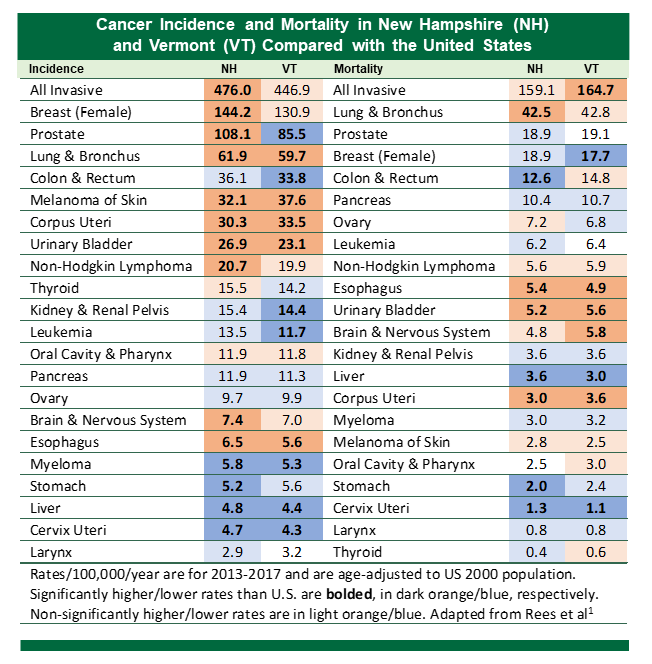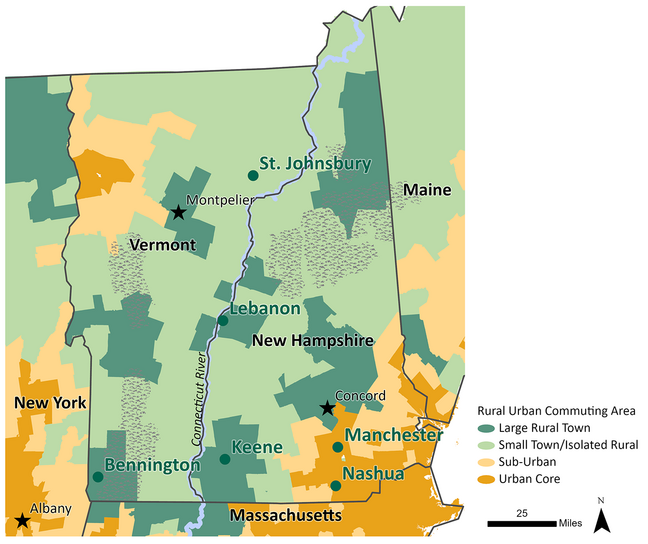Dartmouth Cancer Center is the only National Cancer Institute-designated Comprehensive Cancer Center in New Hampshire and Vermont (our 'catchment area').
We are responsible for understanding and addressing the unique cancer needs and challenges experienced in our community. Our researchers play a central role in ensuring we serve our community well by:
- Aligning research foci to study cancer-related issues impacting our catchment area.
- Engaging community members in shaping our research priorities and influencing how we conduct research.
- Translating, implementing, and disseminating research and evidence.
If you are a Dartmouth Cancer Center research program member and have recently conducted or been involved with community-focused activities, please share them on our Community Outreach and Engagement form.
Please refer to the following sections on this page to learn more:
Our catchment area's cancer burden
Our catchment area has a higher burden of cancer than the United States as a whole1. We have both higher rates of new cancer diagnoses ('incidence') and higher rates of cancer deaths ('mortality')1.
Our catchment area also has a higher incidence of several cancer types compared with the United States (see orange areas, left side of the table), including:
- Bladder cancer
- Brain and nervous system cancer
- Breast cancer
- Esophageal cancer
- Lung and bronchus cancer
- Melanoma
- Non-Hodgkin lymphoma
- Uterine cancer1
Many of these same cancers also add to our catchment area's high cancer mortality rate (see orange areas, right side of the table below)1.
About half of the residents of our catchment area live in rural areas (see map below), and rural areas are more affected by cancer than urban areas.2 For example, in rural areas:
- There is a higher cancer mortality, and the rate is increasing2
- People are more likely to get cervical, colorectal, mouth/throat, and lung cancers2
- Residents are more likely to smoke and less likely to be up to date with important cancer screenings2
Learn more about our catchment area, including data sources and publications.
Our priority areas
In 2021, our Community Advisory Board and other advisors reviewed information about cancer in our catchment area. They chose four cancers as priority areas for us to address through our research and our work in the community:
- Breast cancer
- Colorectal cancer
- Lung cancer
- Melanoma
We continue reviewing new cancer data in our catchment area with our Community Advisory Board. We will update our priority areas, as needed, to ensure we are meeting the needs of our community.
Contact us
To contact the COE team, please email DCC.Community.Outreach@dartmouth.edu. To reach specific team members, please visit our team member page.
Citations
- Rees, J. R., Weiss, J. E., Gunn, C. M., Carlos, H. A., Dragnev, N. C., Supattapone, E. Y., ... & Peacock, J. L. (2023). Cancer Epidemiology in the Northeastern United States (2013–2017). Cancer Research Communications, 3(8), 1538-1550.
- Henley, S. J., Anderson, R. N., Thomas, C. C., Massetti, G. M., Peaker, B., & Richardson, L. C. (2017). Invasive cancer incidence, 2004–2013, and deaths, 2006–2015, in nonmetropolitan and metropolitan counties—United States. MMWR Surveillance Summaries, 66(14), 1.

